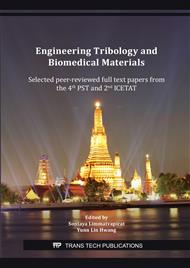p.86
p.92
p.98
p.104
p.111
p.117
p.123
p.129
p.137
Factors Affecting Gelation of Lidocaine Hydrochloride-Loaded Polyelectrolyte Complex Thermosensitivity Gel for Dry Socket Treatment
Abstract:
Dry socket disease, a pocket wound caused by the tooth extraction that resulted in severe acute pain which requires a topical analgesic with rapidly pain reduction and suppress the pain until the wound healed. This study aimed to investigate factors affecting gelation temperature and gelation time of lidocaine hydrochloride (LH)-loaded polyelectrolyte complex (PEC) thermosensitivity gel for treating dry socket wound. The first factor was investigated the effects of the ratio of three different types of polymers as chitosan (CS), hyaluronic acid (HA) and poloxamer407 (P407) on the phase transition caused by temperature. The second factor was examined the effects of gel preparation methods. The results showed that increasing concentration of the cationic polymer as CS induced the separation of the solution to gel (sol-to-gel) system due to the charge of CS and the charge of PEC. The ratio of HA:P407 affected the gel forming which high concentration of P407 reduced the gelation temperature while low concentration of HA disturbed the sol-to-gel state causing coagulation. The viscosity, spreadability, and swelling were significantly increased due to the concomitant increased in each polymer, HA and P407. The particle of the formulation observed under microscope was found to be less than 1 µm. Phase inversion from sol-to-gel was found after a min at 23°C. Since gelation temperature of the purposed formula is supposed to form gel below 37°C within a short period of injection. The results of the study indicate the suitable sol-to-gel forming in the appropriate temperature and time which should be used for further investigation in the efficacy and safety.
Info:
Periodical:
Pages:
111-116
Citation:
Online since:
October 2021
Authors:
Keywords:
Price:
Сopyright:
© 2021 Trans Tech Publications Ltd. All Rights Reserved
Share:
Citation:


